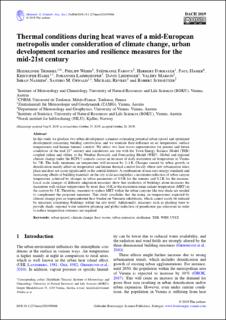| dc.contributor.author | Trimmel, Heidelinde | |
| dc.contributor.author | Weihs, Philipp | |
| dc.contributor.author | Faroux, Stephanie | |
| dc.contributor.author | Formayer, Herbert | |
| dc.contributor.author | Hamer, Paul David | |
| dc.contributor.author | Hasel, Kristoffer | |
| dc.contributor.author | Laimighofer, Johannes | |
| dc.contributor.author | Leidinger, David | |
| dc.contributor.author | Masson, Valery | |
| dc.contributor.author | Nadeem, Imran | |
| dc.contributor.author | Oswald, Sandro M. | |
| dc.contributor.author | Revesz, Michael | |
| dc.contributor.author | Schoetter, Robert | |
| dc.date.accessioned | 2020-03-13T11:34:14Z | |
| dc.date.available | 2020-03-13T11:34:14Z | |
| dc.date.created | 2020-02-24T11:11:41Z | |
| dc.date.issued | 2020 | |
| dc.identifier.citation | Meteorologische Zeitschrift. 2020. | en_US |
| dc.identifier.issn | 0941-2948 | |
| dc.identifier.uri | https://hdl.handle.net/11250/2646717 | |
| dc.description.abstract | In this study we produce two urban development scenarios estimating potential urban sprawl and optimized development concerning building construction, and we simulate their influence on air temperature, surface temperatures and human thermal comfort. We select two heat waves representative for present and future conditions of the mid 21st century and simulations are run with the Town Energy Balance Model (TEB) coupled online and offline to the Weather Research and Forecasting Model (WRF). Global and regional climate change under the RCP8.5 scenario causes an increase of daily maximum air temperature in Vienna by 7 K. The daily minimum air temperature will increase by 2–4 K. Changes caused by urban growth or densification mainly affect air temperature and human thermal comfort locally where new urbanisation takes place and does not occur significantly in the central districts. A combination of near zero-energy standards and increasing albedo of building materials on the city scale accomplishes a maximum reduction of urban canyon temperature achieved by changes in urban parameters of 0.9 K for the minima and 0.2 K for the maxima. Local scale changes of different adaptation measures show that insulation of buildings alone increases the maximum wall surface temperatures by more than 10 K or the maximum mean radiant temperature (MRT) in the canyon by 5 K. Therefore, measures to reduce MRT within the urban canyons like tree shade are needed to complement the proposed measures. This study concludes that the rising air temperatures expected by climate change puts an unprecedented heat burden on Viennese inhabitants, which cannot easily be reduced by measures concerning buildings within the city itself. Additionally, measures such as planting trees to provide shade, regional water sensitive planning and global reduction of greenhouse gas emissions in order to reduce temperature extremes are required. | en_US |
| dc.language.iso | eng | en_US |
| dc.rights | Navngivelse-Ikkekommersiell 4.0 Internasjonal | * |
| dc.rights.uri | http://creativecommons.org/licenses/by-nc/4.0/deed.no | * |
| dc.title | Thermal conditions during heat waves of a mid-European metropolis under consideration of climate change, urban development scenarios and resilience measures for the mid-21st century | en_US |
| dc.type | Peer reviewed | en_US |
| dc.type | Journal article | en_US |
| dc.description.version | publishedVersion | en_US |
| dc.rights.holder | © 2019 The authors | en_US |
| dc.source.pagenumber | 24 | en_US |
| dc.source.journal | Meteorologische Zeitschrift | en_US |
| dc.identifier.doi | 10.1127/metz/2019/0966 | |
| dc.identifier.cristin | 1796913 | |
| cristin.ispublished | false | |
| cristin.fulltext | original | |
| cristin.qualitycode | 1 | |

